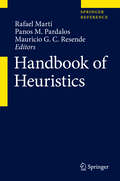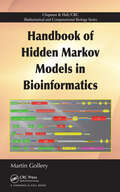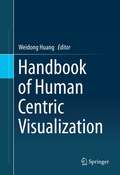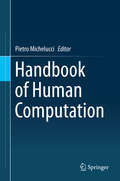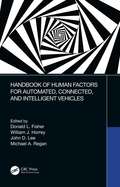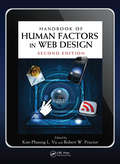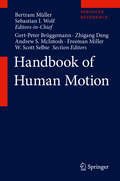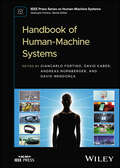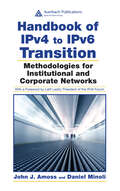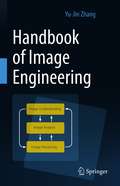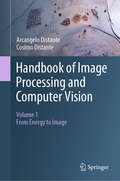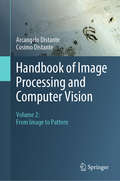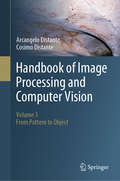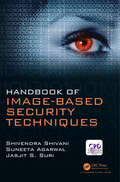- Table View
- List View
Handbook of Heuristics
by Panos M. Pardalos Rafael Martí Mauricio G. ResendeHeuristics are strategies using readily accessible, loosely applicable information to control problem solving. Algorithms, for example, are a type of heuristic. By contrast, Metaheuristics are methods used to design Heuristics and may coordinate the usage of several Heuristics toward the formulation of a single method. GRASP (Greedy Randomized Adaptive Search Procedures) is an example of a Metaheuristic. To the layman, heuristics may be thought of as ‘rules of thumb’ but despite its imprecision, heuristics is a very rich field that refers to experience-based techniques for problem-solving, learning, and discovery. Any given solution/heuristic is not guaranteed to be optimal but heuristic methodologies are used to speed up the process of finding satisfactory solutions where optimal solutions are impractical. The introduction to this Handbook provides an overview of the history of Heuristics along with main issues regarding the methodologies covered. This is followed by Chapters containing various examples of local searches, search strategies and Metaheuristics, leading to an analyses of Heuristics and search algorithms. The reference concludes with numerous illustrations of the highly applicable nature and implementation of Heuristics in our daily life. Each chapter of this work includes an abstract/introduction with a short description of the methodology. Key words are also necessary as part of top-matter to each chapter to enable maximum search engine optimization. Next, chapters will include discussion of the adaptation of this methodology to solve a difficult optimization problem, and experiments on a set of representative problems.
Handbook of Hidden Markov Models in Bioinformatics
by Martin GolleryDemonstrating that many useful resources, such as databases, can benefit most bioinformatics projects, the Handbook of Hidden Markov Models in Bioinformatics focuses on how to choose and use various methods and programs available for hidden Markov models (HMMs).The book begins with discussions on key HMM and related profile methods, incl
Handbook of Human Centric Visualization
by Weidong HuangVisualizations are visual representations of non-visual data. They are produced for people to interact with and to make sense of the underlying data. Rapid advances in display technology and computer power have enabled researchers to produce visually appealing pictures. However, the effectiveness of those pictures in conveying the embedded information to end users has not been fully explored. Handbook of Human Centric Visualization addresses issues related to design, evaluation and application of visualizations. Topics include visualization theories, design principles, evaluation methods and metrics, human factors, interaction methods and case studies. This cutting-edge book includes contributions from well-established researchers worldwide, from diverse disciplines including psychology, visualization and human-computer interaction. This handbook is designed for a professional audience composed of practitioners, lecturers and researchers working in the field of computer graphics, visualization, human-computer interaction and psychology. Undergraduate and postgraduate students in science and engineering focused on this topic will also find this book useful as a comprehensive textbook or reference.
Handbook of Human Computation
by Pietro MichelucciThis volume addresses the emerging area of human computation, The chapters, written by leading international researchers, explore existing and future opportunities to combine the respective strengths of both humans and machines in order to create powerful problem-solving capabilities. The book bridges scientific communities, capturing and integrating the unique perspective and achievements of each. It coalesces contributions from industry and across related disciplines in order to motivate, define, and anticipate the future of this exciting new frontier in science and cultural evolution. Readers can expect to find valuable contributions covering Foundations; Application Domains; Techniques and Modalities; Infrastructure and Architecture; Algorithms; Participation; Analysis; Policy and Security and the Impact of Human Computation. Researchers and professionals will find the Handbook of Human Computation a valuable reference tool. The breadth of content also provides a thorough foundation for students of the field.
Handbook of Human Factors for Automated, Connected, and Intelligent Vehicles
by John D. Lee Michael A. Regan Donald L. Fisher William J. HorreyHandbook of Human Factors for Automated, Connected, and Intelligent Vehicles Subject Guide: Ergonomics & Human Factors Automobile crashes are the seventh leading cause of death worldwide, resulting in over 1.25 million deaths yearly. Automated, connected, and intelligent vehicles have the potential to reduce crashes significantly, while also reducing congestion, carbon emissions, and increasing accessibility. However, the transition could take decades. This new handbook serves a diverse community of stakeholders, including human factors researchers, transportation engineers, regulatory agencies, automobile manufacturers, fleet operators, driving instructors, vulnerable road users, and special populations. It provides information about the human driver, other road users, and human–automation interaction in a single, integrated compendium in order to ensure that automated, connected, and intelligent vehicles reach their full potential. Features Addresses four major transportation challenges—crashes, congestion, carbon emissions, and accessibility—from a human factors perspective Discusses the role of the human operator relevant to the design, regulation, and evaluation of automated, connected, and intelligent vehicles Offers a broad treatment of the critical issues and technological advances for the designing of transportation systems with the driver in mind Presents an understanding of the human factors issues that are central to the public acceptance of these automated, connected, and intelligent vehicles Leverages lessons from other domains in understanding human interactions with automation Sets the stage for future research by defining the space of unexplored questions
Handbook of Human Factors in Web Design (Human Factors and Ergonomics)
by Robert W. Proctor Kim-Phuong L. VuThe Handbook of Human Factors in Web Design covers basic human factors issues relating to screen design, input devices, and information organization and processing, as well as addresses newer features which will become prominent in the next generation of Web technologies. These include multimodal interfaces, wireless capabilities, and agents t
Handbook of Human Motion
by Bertram Müller Sebastian I. Wolf Gert-Peter Brüggemann Zhigang Deng Andrew S. McIntosh Freeman Miller W. Scott SelbieThe Handbook of Human Motion is a large cross-disciplinary reference work which covers the many interlinked facets of the science and technology of human motion and its measurement. Individual chapters cover fundamental principles and technological developments, the state-of-the-art and consider applications across four broad and interconnected fields; medicine, sport, forensics and animation. The huge strides in technological advancement made over the past century make it possible to measure motion with unprecedented precision, but also lead to new challenges. This work introduces the many different approaches and systems used in motion capture, including IR and ultrasound, mechanical systems and video, plus some emerging techniques. The large variety of techniques used for the study of motion science in medicine can make analysis a complicated process, but extremely effective for the treatment of the patient when well utilised. The handbook describes how motion capture techniques are applied in medicine, and shows how the resulting analysis can help in diagnosis and treatment. A closely related field, sports science involves a combination of in-depth medical knowledge and detailed understanding of performance and training techniques, and motion capture can play an extremely important role in linking these disciplines. The handbook considers which technologies are most appropriate in specific circumstances, how they are applied and how this can help prevent injury and improve sporting performance. The application of motion capture in forensic science and security is reviewed, with chapters dedicated to specific areas including employment law, injury analysis, criminal activity and motion/facial recognition. And in the final area of application, the book describes how novel motion capture techniques have been designed specifically to aid the creation of increasingly realistic animation within films and video games, with Lord of the Rings and Avatar just two examples. Chapters will provide an overview of the bespoke motion capture techniques developed for animation, how these have influenced advances in film and game design, and the links to behavioural studies, both in humans and in robotics. Comprising a cross-referenced compendium of different techniques and applications across a broad field, the Handbook of Human Motion provides the reader with a detailed reference and simultaneously a source of inspiration for future work. The book will be of use to students, researchers, engineers and others working in any field relevant to human motion capture.
Handbook of Human-Machine Systems (IEEE Press Series on Human-Machine Systems)
by Giancarlo Fortino Andreas Nürnberger David Kaber David MendonçaHandbook of Human-Machine Systems Insightful and cutting-edge discussions of recent developments in human-machine systems In Handbook of Human-Machine Systems, a team of distinguished researchers delivers a comprehensive exploration of human-machine systems (HMS) research and development from a variety of illuminating perspectives. The book offers a big picture look at state-of-the-art research and technology in the area of HMS. Contributing authors cover Brain-Machine Interfaces and Systems, including assistive technologies like devices used to improve locomotion. They also discuss advances in the scientific and engineering foundations of Collaborative Intelligent Systems and Applications. Companion technology, which combines trans-disciplinary research in fields like computer science, AI, and cognitive science, is explored alongside the applications of human cognition in intelligent and artificially intelligent system designs, human factors engineering, and various aspects of interactive and wearable computers and systems. The book also includes: A thorough introduction to human-machine systems via the use of emblematic use cases, as well as discussions of potential future research challenges Comprehensive explorations of hybrid technologies, which focus on transversal aspects of human-machine systems Practical discussions of human-machine cooperation principles and methods for the design and evaluation of a brain-computer interface Perfect for academic and technical researchers with an interest in HMS, Handbook of Human-Machine Systems will also earn a place in the libraries of technical professionals practicing in areas including computer science, artificial intelligence, cognitive science, engineering, psychology, and neurobiology.
Handbook of IPv4 to IPv6 Transition: Methodologies for Institutional and Corporate Networks
by Daniel Minoli John J. AmossThe implementation of IPv6 is essential to the continued growth of the Internet and the development of new applications. The Handbook of IPv4 to IPv6 Transition Methodologies provides a wealth of best practices and procedures that will help corporations plan and implement a smooth transition to IPv6.A blueprint for successful transition, the Handbo
Handbook of Image Engineering
by Yu-Jin ZhangImage techniques have been developed and implemented for various purposes, and image engineering (IE) is a rapidly evolving, integrated discipline comprising the study of all the different branches of image techniques, and encompassing mathematics, physics, biology, physiology, psychology, electrical engineering, computer science and automation. Advances in the field are also closely related to the development of telecommunications, biomedical engineering, remote sensing, surveying and mapping, as well as document processing and industrial applications. IE involves three related and partially overlapping groups of image techniques: image processing (IP) (in its narrow sense), image analysis (IA) and image understanding (IU), and the integration of these three groups makes the discipline of image engineering an important part of the modern information era. This is the first handbook on image engineering, and provides a well-structured, comprehensive overview of this new discipline. It also offers detailed information on the various image techniques. It is a valuable reference resource for R&D professional and undergraduate students involved in image-related activities.
Handbook of Image Processing and Computer Vision: Volume 1: From Energy to Image
by Cosimo Distante Arcangelo DistanteAcross three volumes, the Handbook of Image Processing and Computer Vision presents a comprehensive review of the full range of topics that comprise the field of computer vision, from the acquisition of signals and formation of images, to learning techniques for scene understanding. The authoritative insights presented within cover all aspects of the sensory subsystem required by an intelligent system to perceive the environment and act autonomously. Volume 1 (From Energy to Image) examines the formation, properties, and enhancement of a digital image.Topics and features:• Describes the fundamental processes in the field of artificial vision that enable the formation of digital images from light energy• Covers light propagation, color perception, optical systems, and the analog-to-digital conversion of the signal• Discusses the information recorded in a digital image, and the image processing algorithms that can improve the visual qualities of the image• Reviews boundary extraction algorithms, key linear and geometric transformations, and techniques for image restoration• Presents a selection of different image segmentation algorithms, and of widely-used algorithms for the automatic detection of points of interest• Examines important algorithms for object recognition, texture analysis, 3D reconstruction, motion analysis, and camera calibration• Provides an introduction to four significant types of neural network, namely RBF, SOM, Hopfield, and deep neural networksThis all-encompassing survey offers a complete reference for all students, researchers, and practitioners involved in developing intelligent machine vision systems. The work is also an invaluable resource for professionals within the IT/software and electronics industries involved in machine vision, imaging, and artificial intelligence.Dr. Cosimo Distante is a Research Scientist in Computer Vision and Pattern Recognition in the Institute of Applied Sciences and Intelligent Systems (ISAI) at the Italian National Research Council (CNR). Dr. Arcangelo Distante is a researcher and the former Director of the Institute of Intelligent Systems for Automation (ISSIA) at the CNR. His research interests are in the fields of Computer Vision, Pattern Recognition, Machine Learning, and Neural Computation.
Handbook of Image Processing and Computer Vision: Volume 2: From Image to Pattern
by Cosimo Distante Arcangelo DistanteAcross three volumes, the Handbook of Image Processing and Computer Vision presents a comprehensive review of the full range of topics that comprise the field of computer vision, from the acquisition of signals and formation of images, to learning techniques for scene understanding. The authoritative insights presented within cover all aspects of the sensory subsystem required by an intelligent system to perceive the environment and act autonomously. Volume 2 (From Image to Pattern) examines image transforms, image restoration, and image segmentation.Topics and features:• Describes the fundamental processes in the field of artificial vision that enable the formation of digital images from light energy• Covers light propagation, color perception, optical systems, and the analog-to-digital conversion of the signal• Discusses the information recorded in a digital image, and the image processing algorithms that can improve the visual qualities of the image• Reviews boundary extraction algorithms, key linear and geometric transformations, and techniques for image restoration• Presents a selection of different image segmentation algorithms, and of widely-used algorithms for the automatic detection of points of interest• Examines important algorithms for object recognition, texture analysis, 3D reconstruction, motion analysis, and camera calibration• Provides an introduction to four significant types of neural network, namely RBF, SOM, Hopfield, and deep neural networksThis all-encompassing survey offers a complete reference for all students, researchers, and practitioners involved in developing intelligent machine vision systems. The work is also an invaluable resource for professionals within the IT/software and electronics industries involved in machine vision, imaging, and artificial intelligence.Dr. Cosimo Distante is a Research Scientist in Computer Vision and Pattern Recognition in the Institute of Applied Sciences and Intelligent Systems (ISAI) at the Italian National Research Council (CNR). Dr. Arcangelo Distante is a researcher and the former Director of the Institute of Intelligent Systems for Automation (ISSIA) at the CNR. His research interests are in the fields of Computer Vision, Pattern Recognition, Machine Learning, and Neural Computation.
Handbook of Image Processing and Computer Vision: Volume 3: From Pattern to Object
by Cosimo Distante Arcangelo DistanteAcross three volumes, the Handbook of Image Processing and Computer Vision presents a comprehensive review of the full range of topics that comprise the field of computer vision, from the acquisition of signals and formation of images, to learning techniques for scene understanding. The authoritative insights presented within cover all aspects of the sensory subsystem required by an intelligent system to perceive the environment and act autonomously. Volume 3 (From Pattern to Object) examines object recognition, neural networks, motion analysis, and 3D reconstruction of a scene.Topics and features:• Describes the fundamental processes in the field of artificial vision that enable the formation of digital images from light energy• Covers light propagation, color perception, optical systems, and the analog-to-digital conversion of the signal• Discusses the information recorded in a digital image, and the image processing algorithms that can improve the visual qualities of the image• Reviews boundary extraction algorithms, key linear and geometric transformations, and techniques for image restoration• Presents a selection of different image segmentation algorithms, and of widely-used algorithms for the automatic detection of points of interest• Examines important algorithms for object recognition, texture analysis, 3D reconstruction, motion analysis, and camera calibration• Provides an introduction to four significant types of neural network, namely RBF, SOM, Hopfield, and deep neural networksThis all-encompassing survey offers a complete reference for all students, researchers, and practitioners involved in developing intelligent machine vision systems. The work is also an invaluable resource for professionals within the IT/software and electronics industries involved in machine vision, imaging, and artificial intelligence.Dr. Cosimo Distante is a Research Scientist in Computer Vision and Pattern Recognition in the Institute of Applied Sciences and Intelligent Systems (ISAI) at the Italian National Research Council (CNR). Dr. Arcangelo Distante is a researcher and the former Director of the Institute of Intelligent Systems for Automation (ISSIA) at the CNR. His research interests are in the fields of Computer Vision, Pattern Recognition, Machine Learning, and Neural Computation.
Handbook of Image-based Security Techniques
by Jasjit S. Suri Shivendra Shivani Suneeta AgarwalThis book focuses on image based security techniques, namely visual cryptography, watermarking, and steganography. This book is divided into four sections. The first section explores basic to advanced concepts of visual cryptography. <P><P>The second section of the book covers digital image watermarking including watermarking algorithms, frameworks for modeling watermarking systems, and the evaluation of watermarking techniques. The next section analyzes steganography and steganalysis, including the notion, terminology and building blocks of steganographic communication. <P><P>The final section of the book describes the concept of hybrid approaches which includes all image-based security techniques. One can also explore various advanced research domains related to the multimedia security field in the final section. The book includes many examples and applications, as well as implementation using MATLAB, wherever required. <P><P>Features: <li>Provides a comprehensive introduction to visual cryptography, digital watermarking and steganography in one book <li>Includes real-life examples and applications throughout <li>Covers theoretical and practical concepts related to security of other multimedia objects using image based security techniques <li>Presents the implementation of all important concepts in MATLAB
Handbook of Inclusive Knowledge Management: Ensuring Inclusivity, Diversity, and Equity in Knowledge Processing Activities
by Kimiz DalkirHandbook of Inclusive Knowledge Management: Ensuring Inclusivity, Diversity, and Equity in Knowledge Processing Activities examines the role that diversity, equity and inclusivity (DEI) plays in the field and discipline of knowledge management (KM). With the premise that DEI is the inclusion and equal treatment of all types of people, things and viewpoints, the book aims to increase awareness of DEI among KM practitioners and researchers. It is a starting point for adopting knowledge processing activities that ensure all knowledge voices are represented in knowledge creation and capture. The book explains how this valuable knowledge can be shared and disseminated so that there is equitable access as well as knowledge. The focus of this handbook is on inclusivity in KM, its current state, specific challenges and an exploration of the best path forward.Currently, inclusivity does not appear to be on many KM road maps, and this book provides insights into the state-of-the-art of inclusivity in KM. In alignment with the book’s central theme, it presents a diverse range of perspectives that includes KM researchers, KM educators and KM practitioners. Addressing different stages of knowledge processing, as well as the KM bookends of KM culture, KM competencies and KM governance, the book features in-depth case studies to illustrate how inclusivity can be integrated into KM. The handbook concludes with concrete recommendations on how to integrate inclusivity into KM in organizations. Reviewing both the theory and practice of inclusive KM, the book helps readers gain actionable insights into an inclusive KM approach that includes standards, guidelines and checklists.
Handbook of Industrial and Business Applications with Digital Twins
by Saravanan Krishnan A. Jose Anand S. SendhilkumarA digital twin represents the indistinguishable digital counterpart of the physical object to simulate, monitor and test with real time synchronization. This book presents the framework and important key aspects of digital twins, including various technologies with coverage of the digital twins in various industry and business applications. It provides a background of modeling and simulation, computer sensor technology and other areas required creating the next wave of digital twins.Features: Presents exclusive material on industrial and business applications of digital twins Includes diversified digital twin applications with use cases Focuses on tools and methods for digital twins, platforms, application domains and industries Emphasizes advances and cutting-edge technologies throughout Reviews artificial intelligence (AI), fog/edge computing, industrial automation, blockchains and the Internet of Things (IoT) This book is aimed at researchers and graduate students in cloud computing, simulation, the IoT and computer engineering.
Handbook of Industry 4.0 and SMART Systems
by Uday Kumar Diego Galar Pascual Pasquale DaponteIndustry 4.0 refers to fourth generation of industrial activity characterized by smart systems and internet-based solutions. This book describes the fourth revolution based on instrumented, interconnected and intelligent assets. The different book chapters provide a perspective on technologies and methodologies developed and deployed leading to this concept. With an aim to increase performance, productivity and flexibility, major application area of maintenance through smart system has been discussed in detail. Applicability of 4.0 in transportation, energy and infrastructure is explored, with effects on technology, organisation and operations from a systems perspective.
Handbook of Integration of Cloud Computing, Cyber Physical Systems and Internet of Things (Scalable Computing and Communications)
by Lizhe Wang Albert Y. Zomaya Rajiv Ranjan Karan Mitra Prem Prakash JayaramanThis handbook covers recent advances in the integration of three areas, namely, cloud computing, cyber-physical systems, and the Internet of things which is expected to have a tremendous impact on our daily lives. It contains a total of thirteen peer-reviewed and edited chapters. This book covers topics such as context-aware cyber-physical systems, sustainable cloud computing, fog computing, and cloud monitoring; both the theoretical and practical aspects belonging to these topics are discussed. All the chapters also discuss open research challenges in the areas mentioned above. Finally, the handbook presents three use cases regarding healthcare, smart buildings and disaster management to assist the audience in understanding how to develop next-generation IoT- and cloud-enabled cyber-physical systems. This timely handbook is edited for students, researchers, as well as professionals who are interested in the rapidly growing fields of cloud computing, cyber-physical systems, and the Internet of things.
Handbook of Intelligent Automation Systems Using Computer Vision and Artificial Intelligence
by Susheela Hooda Durgesh Srivastava Rupali Gill Shilpi HarnalThe book is essential for anyone seeking to understand and leverage the transformative power of intelligent automation technologies, providing crucial insights into current trends, challenges, and effective solutions that can significantly enhance operational efficiency and decision-making within organizations. Intelligent automation systems, also called cognitive automation, use automation technologies such as artificial intelligence, business process management, and robotic process automation, to streamline and scale decision-making across organizations. Intelligent automation simplifies processes, frees up resources, improves operational efficiencies, and has a variety of applications. Intelligent automation systems aim to reduce costs by augmenting the workforce and improving productivity and accuracy through consistent processes and approaches, which enhance quality, improve customer experience, and address compliance and regulations with confidence. Handbook of Intelligent Automation Systems Using Computer Vision and Artificial Intelligence explores the significant role, current trends, challenges, and potential solutions to existing challenges in the field of intelligent automation systems, making it an invaluable guide for researchers, industry professionals, and students looking to apply these innovative technologies. Readers will find the volume: Offers comprehensive coverage on intelligent automation systems using computer vision and AI, covering everything from foundational concepts to real-world applications and ethical considerations; Provides actionable knowledge with case studies and best practices for intelligent automation systems, computer vision, and AI; Explores the integration of various techniques, including facial recognition, natural language processing, neuroscience and neuromarketing. Audience The book is designed for AI and data scientists, software developers and engineers in industry and academia, as well as business leaders and entrepreneurs who are interested in the applications of intelligent automation systems.
Handbook of Intelligent Vehicles
by Azim EskandarianThe Handbook of Intelligent Vehicles provides a complete coverage of the fundamentals, new technologies, and sub-areas essential to the development of intelligent vehicles; it also includes advances made to date, challenges, and future trends. Significant strides in the field have been made to date; however, so far there has been no single book or volume which captures these advances in a comprehensive format, addressing all essential components and subspecialties of intelligent vehicles, as this book does. Since the intended users are engineering practitioners, as well as researchers and graduate students, the book chapters do not only cover fundamentals, methods, and algorithms but also include how software/hardware are implemented, and demonstrate the advances along with their present challenges. Research at both component and systems levels are required to advance the functionality of intelligent vehicles. This volume covers both of these aspects in addition to the fundamentals listed above.
Handbook of Intelligent and Sustainable Smart Dentistry: Nature and Bio-Inspired Approaches, Processes, Materials, and Manufacturing (Advancements in Intelligent and Sustainable Technologies and Systems)
by Ajay Kumar Sidhu Surbhi Bhatia Khan Sarita Rathee Namrata DograWith the exponential growth of science and technology, the delivery of dental care has shifted from conventional methods to intelligent techniques. In addition to adapting intelligent techniques, sustainable dental practice is of the utmost importance. Eco-friendly dentistry, sustainable dentistry, or green dentistry are approaches that reduce the environmental impact of dental practice and help safeguard planetary and community well-being. This handbook provides the latest and most comprehensive evidence-based guidance on intelligent and sustainable approaches in dentistry.Handbook of Intelligent and Sustainable Smart Dentistry: Nature and Bio-Inspired Approaches, Processes, Materials, and Manufacturing highlights how Dentistry 4.0 has come to the rescue after COVID-19 and how it has helped in providing needed e-healthcare. This handbook bridges the gap between research and development in the field of smart dentistry for professionals and clinicians. Intelligent materials, equipment, instrumentation, and the latest behavior management techniques and how these techniques provide superior care and treatment to society are explored in detail. The scope of nature-inspired techniques and procession, along with green solutions, are also discussed in this one-of-a-kind handbook.This valuable handbook is a single-stop solution for practitioners, researchers, scholars, students, academicians, and clinicians interested in updating their knowledge on intelligent and sustainable dentistry. The handbook will bestow the readers with not only theoretical knowledge but will equip them with clinical skills as well.
Handbook of Internet Computing (Internet And Communications Ser. #5)
by Borko FurhtScientists in different geographical locations conduct real-time experiments in a virtual shared workspace. E-commerce provides an emerging market for businesses large and small. E-mail, Servers, and Enterprise Resources Planning have revolutionized businesses on every level. People from all over the globe gather in chat rooms. The Internet is here to stay and Internet technologies and applications continue to grow and evolve.The Handbook of Internet Computing presents comprehensive coverage of all technical issues related to the Internet and its applications. It addresses hot topics such as Internet architectures, content-based multimedia retrieval on the Internet, Web-based collaboration, Web search engines, digital libraries, and more. Real-life examples illustrate the concepts so that technical, non-technical and business people can quickly grasp the fundamentals.
Handbook of IoT and Big Data (Science, Technology, and Management)
by J. Paulo Davim Vijender Kumar Solanki Vicente García DíazThis multi-contributed handbook focuses on the latest workings of IoT (internet of Things) and Big Data. As the resources are limited, it's the endeavor of the authors to support and bring the information into one resource. The book is divided into 4 sections that covers IoT and technologies, the future of Big Data, algorithms, and case studies showing IoT and Big Data in various fields such as health care, manufacturing and automation. Features Focuses on the latest workings of IoT and Big Data Discusses the emerging role of technologies and the fast-growing market of Big Data Covers the movement toward automation with hardware, software, and sensors, and trying to save on energy resources Offers the latest technology on IoT Presents the future horizons on Big Data
Handbook of IoT and Blockchain: Methods, Solutions, and Recent Advancements (Internet of Everything (IoE))
by Brojo Kishore Mishra, Sanjay Kumar Kuanar, Sheng-Lung Peng, and Daniel D. DasigHandbook of IoT and Blockchain: Methods, solutions, and Recent Advancements includes contributions from around the globe on recent advances and findings in the domain of Internet of Things (IoT) and Blockchain. Chapters include theoretical analysis, practical implications, and extensive surveys with analysis on methods, algorithms, and processes for new product development. IoT and Blockchain are the emerging topics in the current manufacturing scenario.This handbook includes recent advances; showcases the work of research around the globe; offers theoretical analysis and practical implications; presents extensive surveys with analysis, new contributions, and proposals on methods, algorithms, and processes; and also covers recent advances from quantitative and qualitative articles, case studies, conceptual works, and theoretical backing. This handbook will be of interest to graduate students, researchers, academicians, institutions, and professionals that are interested in exploring the areas of IoT and Blockchain.
Handbook of Iris Recognition
by Mark J. Burge Kevin BowyerThis authoritative collection introduces the reader to the state of the art in iris recognition technology. Topics and features: with a Foreword by the "father of iris recognition," Professor John Daugman of Cambridge University; presents work from an international selection of preeminent researchers, reflecting the uses of iris recognition in many different social contexts; provides viewpoints from researchers in government, industry and academia, highlighting how iris recognition is both a thriving industry and an active research area; surveys previous developments in the field, and covers topics ranging from the low-level (e.g., physics of iris image acquisition) to the high level (e.g., alternative non-Daugman approaches to iris matching); introduces many active and open areas of research in iris recognition, including cross-wavelength matching and iris template aging. This book is an essential resource for anyone wishing to improve their understanding of iris recognition technology.
